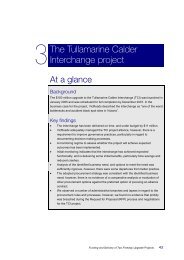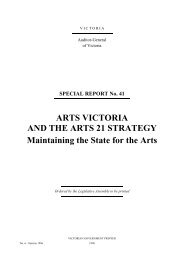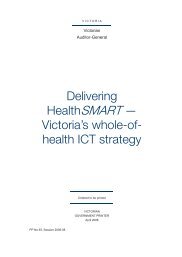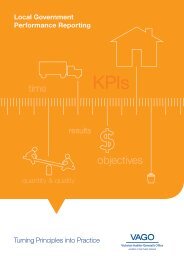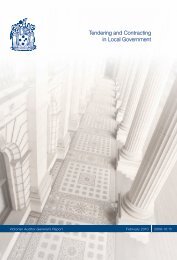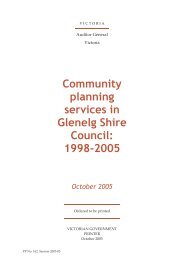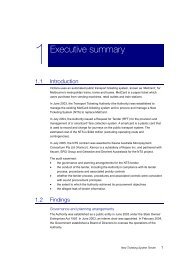New ticketing system tender
New ticketing system tender
New ticketing system tender
Create successful ePaper yourself
Turn your PDF publications into a flip-book with our unique Google optimized e-Paper software.
1<br />
Executive summary<br />
1.1 Introduction<br />
Victoria uses an automated public transport <strong>ticketing</strong> <strong>system</strong>, known as ‘MetCard’, for<br />
Melbourne’s metropolitan trains, trams and buses. MetCard is a paper ticket which<br />
users purchase from vending machines, retail outlets and train stations.<br />
In June 2003, the Transport Ticketing Authority (the Authority) was established to<br />
manage the existing MetCard <strong>ticketing</strong> <strong>system</strong> and to procure and manage a <strong>New</strong><br />
Ticketing System (NTS) to replace MetCard.<br />
In July 2004, the Authority issued a Request for Tender (RFT) for the provision and<br />
management of a ‘smartcard’ fare collection <strong>system</strong>. A smartcard is a plastic card that<br />
is used to record and charge for journeys on the public transport <strong>system</strong>. The<br />
estimated cost of the NTS is $494 million (excluding operating costs and<br />
contingencies).<br />
In July 2005, the NTS contract was awarded to Keane Australia Micropayment<br />
Consortium Pty Ltd (‘Kamco’). Kamco is a subsidiary of Keane Inc. and partnered with<br />
Ascom, ERG Group and Geisecke and Devrient Australasia for the NTS project.<br />
The audit examined:<br />
• the governance and planning arrangements for the NTS <strong>tender</strong><br />
• the conduct of the <strong>tender</strong>, including the Authority’s compliance with its <strong>tender</strong><br />
process, procedures and associated probity controls<br />
• whether the <strong>tender</strong> process, procedures and associated controls were consistent<br />
with sound procurement principles<br />
• the extent to which the Authority achieved its procurement objectives<br />
• the alleged leak of <strong>tender</strong> information.<br />
1.2 Findings<br />
Governance and planning arrangements<br />
The Authority was established as a public entity in June 2003 under the State Owned<br />
Enterprises Act 1992. In June 2003, an interim chair was appointed. In February 2004,<br />
the Government established a Board of Directors to oversee the operations of the<br />
Authority.<br />
<strong>New</strong> Ticketing System Tender 1
Executive summary<br />
2 <strong>New</strong> Ticketing System Tender<br />
Between the release of the RFT (30 July 2004) and the Board’s recommendation of the<br />
successful <strong>tender</strong>er (10 June 2005), the Board met nine times. The conduct of the<br />
Board meetings and out-of-session briefings and approvals were consistent with<br />
contemporary approaches to corporate governance.<br />
While the Board was expanded late in the <strong>tender</strong> process to comprise three members<br />
(the statutory limit is five members), for most of the <strong>tender</strong> period the Board consisted<br />
of two members. Given the size and complexity of the <strong>tender</strong>, a larger Board was<br />
warranted.<br />
The Authority established an Audit Committee with two members to assist the Board.<br />
At the time of the NTS <strong>tender</strong>, these two individuals were also members of the Board.<br />
A larger Audit Committee, with at least one external member, would have<br />
provided a higher degree of assurance about the Authority’s governance,<br />
compliance and performance.<br />
The Authority established an evaluation committee comprising five senior executives<br />
from the Authority, the Authority’s senior legal advisor, and representatives from the<br />
Departments of Treasury and Finance and Infrastructure. The evaluation committee<br />
was supported by five advisory teams comprising Authority staff, external experts and<br />
advisors. Four senior Authority managers were members of both the evaluation<br />
committee and one or more advisory committees. The accountability arrangements<br />
would have been strengthened had the senior managers participated in either<br />
the evaluation committee or the advisory teams but not both.<br />
In a major <strong>tender</strong>, the role of a Probity Advisor is to establish and manage the probity<br />
approach, while the role of a Probity Auditor is to independently review the nature and<br />
conduct of the probity approach. In the case of the NTS <strong>tender</strong>, the Probity Auditor and<br />
Probity Advisor roles were combined. While combining the roles may benefit a<br />
<strong>tender</strong>ing authority through cost savings and efficiencies, having a separate<br />
Probity Auditor role provides a higher level of assurance about the standard of<br />
<strong>tender</strong> probity. Combining the roles serves to confuse accountabilities and may<br />
weaken public confidence in the probity of a <strong>tender</strong>.<br />
As a non-departmental public entity, the Authority was not required to comply with the<br />
<strong>tender</strong>ing guidelines issued by the Minister for Finance, the Department of Treasury<br />
and Finance and the Victorian Government Purchasing Board (VGPB). The Authority<br />
had adequate policies and procedures in place to ensure compliance with the<br />
VGPB guidelines.<br />
The Authority began planning the NTS <strong>tender</strong> in late 2003, building on a significant<br />
body of research undertaken by the Authority’s precursor, the Public Transport<br />
Ticketing Taskforce. The Authority’s planning for the NTS <strong>tender</strong> was completed before<br />
the initial date for the close of <strong>tender</strong>s. The essential plans, processes and<br />
administrative arrangements were all in place when the NTS <strong>tender</strong> commenced.
Management of the NTS <strong>tender</strong><br />
Executive summary<br />
There are only a small number of suppliers of automated <strong>ticketing</strong> <strong>system</strong>s worldwide.<br />
Two major equipment suppliers dominate the Australian market. Most of the <strong>ticketing</strong><br />
<strong>system</strong>s acquired around the world have involved a long-term contract for the supply of<br />
a proprietary <strong>system</strong>. Such arrangements have created technical barriers to<br />
purchasing authorities, with respect to:<br />
• obtaining the best <strong>ticketing</strong> <strong>system</strong><br />
• changing equipment or suppliers during the contract period if the <strong>system</strong>s and<br />
equipment fail to operate as required.<br />
The NTS procurement approach was designed to overcome these problems by:<br />
• breaking the <strong>system</strong> into a number of separate components<br />
• establishing a <strong>system</strong> where component parts were interchangeable (through the<br />
use of open architecture).<br />
Rather than providing detailed specification requirements, the Authority set out desired<br />
outputs and outcomes and gave the <strong>tender</strong>ers considerable flexibility in how to meet<br />
the desired outputs and outcomes.<br />
Audit assessed the NTS <strong>tender</strong> against the high-level objectives that were being<br />
sought from the <strong>tender</strong>, namely:<br />
• high levels of performance<br />
• timeliness and smooth transition<br />
• <strong>system</strong>s flexibility<br />
• value for money.<br />
Audit found that the <strong>tender</strong> process was largely successful in meeting the<br />
Authority’s objectives:<br />
• the Authority established a procurement process which emphasised customers’<br />
requirements and the selection of a solution that would provide for the future<br />
needs of the Victorian community<br />
• the procurement phase of the NTS project was timely when compared with other<br />
<strong>ticketing</strong> <strong>tender</strong>s in Australia and overseas<br />
• transition to the new <strong>system</strong> should be assisted by the transitional agreement<br />
established between the Authority and the current operator. Also, transition is<br />
likely to be facilitated by the fact that the current <strong>ticketing</strong> operator is involved in<br />
the successful <strong>tender</strong>er’s consortium<br />
• the <strong>tender</strong> process adopted by the Authority enabled it to attract more <strong>tender</strong>s<br />
than other comparable <strong>ticketing</strong> projects had received<br />
• the contract price submitted by the successful <strong>tender</strong>er was within the budget set<br />
by the State Government and satisfied the Authority’s internal benchmark. The<br />
procurement process was successful in reducing the <strong>tender</strong> prices initially<br />
submitted by around 35 to 40 per cent. It is likely that, if the selected <strong>tender</strong> is<br />
delivered as agreed, value for money will be achieved.<br />
<strong>New</strong> Ticketing System Tender 3
Executive summary<br />
4 <strong>New</strong> Ticketing System Tender<br />
Audit also assessed the key elements of the Authority’s management of the NTS<br />
<strong>tender</strong>, namely:<br />
• the resourcing of the <strong>tender</strong> management team<br />
• steps taken to inform potential <strong>tender</strong>ers about what was being sought, the<br />
procurement approach and the <strong>tender</strong> process<br />
• management of changes to the <strong>tender</strong> process and requirements<br />
• the evaluation of <strong>tender</strong>s<br />
• the conduct of negotiation with one or more shortlisted <strong>tender</strong>ers, and clarification<br />
of the shortlisted <strong>tender</strong>s<br />
• documentation of the <strong>tender</strong> process.<br />
Audit identified a number of areas of good practice, as well as areas for<br />
improvement and lessons for wider application to future major <strong>tender</strong>s.<br />
The Authority engaged sufficient staff with <strong>ticketing</strong> and <strong>tender</strong>ing experience, and the<br />
<strong>tender</strong> team had sufficient access to specialist services and skills.<br />
The Authority conducted market soundings in January and May 2004. The soundings<br />
were an effective way of informing potential <strong>tender</strong>ers about the goods and services<br />
being sought, other aspects of the <strong>tender</strong> requirements, and the proposed<br />
procurement approach. Up to the receipt of initial offers, the Authority successfully<br />
communicated with <strong>tender</strong>ers and potential <strong>tender</strong>ers about the solution being sought<br />
and the nature of the <strong>tender</strong> process.<br />
After the receipt of low-quality initial offers, the Authority implemented an interactive<br />
approach (which was permitted by the RFT). The process was unfamiliar to several<br />
<strong>tender</strong>ers. While the Authority and the Probity Auditor took extensive steps to keep all<br />
<strong>tender</strong>ers well informed, some <strong>tender</strong>ers told audit that they needed more information<br />
about the process as it evolved. Also, despite the steps taken to inform the market,<br />
some <strong>tender</strong>ers did not fully appreciate the implications of the ‘outcomes’ approach to<br />
the <strong>tender</strong>. Additional steps could have been taken to:<br />
• apprise <strong>tender</strong>ers of the procurement approach, and its implications for the<br />
<strong>tender</strong> requirements and compliance requirements<br />
• revisit the control framework and risk framework in light of the evolving approach.<br />
During the negotiation stage, approximately 54 Authority staff, consultants,<br />
departmental staff and transport operator staff had direct access to <strong>tender</strong>ers (the<br />
majority of the access was through clarification sessions rather than negotiation<br />
meetings). While the subject matter of the <strong>tender</strong> and the clarification sessions<br />
necessitated a high degree of involvement of technical specialists, the number<br />
of people with direct access to <strong>tender</strong>ers was high. This increased the risk of<br />
uncontrolled information flows.<br />
A three-part <strong>tender</strong> rating <strong>system</strong> was used in the NTS <strong>tender</strong>. The rating <strong>system</strong><br />
did not indicate the difference between <strong>tender</strong>s within each category, and did not<br />
provide a precise assessment of how close each <strong>tender</strong> was to meeting the<br />
<strong>tender</strong> requirements. A more fine-grained <strong>system</strong> would have:
Executive summary<br />
• shown more meaningfully the relative position of <strong>tender</strong>s<br />
• allowed the Authority to more clearly match the assigned rating to the<br />
evaluation narrative<br />
• given a clearer representation of the progress of <strong>tender</strong>s over time.<br />
While the NTS <strong>tender</strong> evaluation reports identified the areas where <strong>tender</strong>s did not<br />
meet the RFT requirements, the reports did not articulate which requirements were<br />
critical or threshold issues and which were not. For those requirements that were<br />
negotiable to some extent, this extent was not specified. The clear articulation of a<br />
maximum acceptable level of risk acceptance by government would have<br />
enabled the decision-makers to determine with more precision and confidence<br />
whether the departures from the RFT requirements were minor, or whether they<br />
were such that the desired solution could not be acquired within the budget<br />
without an unacceptable allocation of risk.<br />
Probity of the NTS <strong>tender</strong><br />
While flexible and innovative approaches to <strong>tender</strong>ing can enhance value for money<br />
for public procurers, the importance of probity is just as great in new types of <strong>tender</strong>ing<br />
as it is in traditional procurement processes.<br />
Due to the specialised nature of <strong>ticketing</strong> <strong>system</strong>s, it was highly likely that a number of<br />
Authority staff would have potential conflicts of interest from prior experience with<br />
organisations <strong>tender</strong>ing for the NTS project. The Probity Auditor identified more than<br />
30 staff and other individuals involved in the <strong>tender</strong> evaluation process who had<br />
potential conflicts of interest. Seven staff members and one consultant were rated as<br />
high risk. Most of the conflicts of interest resulted from previous work histories and/or<br />
shares in two companies included in consortia <strong>tender</strong>ing for the NTS.<br />
All shareholdings were disclosed to the Authority in conflict of interest statements<br />
signed by staff and consultants and were identified in the work undertaken by the NTS<br />
Probity Auditor. All of the declared shareholdings were modest and most were<br />
immaterial.<br />
The most significant shareholding of relevance to the <strong>tender</strong> was the CEO’s<br />
shareholding in Headstrong / James Martin & Co. The shareholding’s potential to<br />
damage community confidence in the <strong>tender</strong> was high. The Authority could have taken<br />
additional steps to address perceived conflicts in relation to the shareholding.<br />
Some senior Authority managers had shared work histories with a number of members<br />
of the <strong>tender</strong>ing consortia. These shared work histories and other relevant<br />
relationships were disclosed to the Authority. The Authority informed <strong>tender</strong>ers about<br />
those people in the Authority who had prior experience with <strong>tender</strong>ers.<br />
The Authority identified the conflicts of interest in a timely way. Audit found no evidence<br />
of corruption in the NTS <strong>tender</strong>, and no evidence that the conflicts of interest led to the<br />
unfair or biased treatment of particular <strong>tender</strong>ers or groups of <strong>tender</strong>ers. Nevertheless,<br />
the Authority could have taken additional steps to communicate to <strong>tender</strong>ers, the<br />
<strong>New</strong> Ticketing System Tender 5
Executive summary<br />
6 <strong>New</strong> Ticketing System Tender<br />
government and the community, how it was managing the real and perceived conflicts<br />
that arose in the <strong>tender</strong>.<br />
In interactive <strong>tender</strong>s, the risks of inappropriate information flows are particularly high.<br />
In the case of the NTS <strong>tender</strong>, most communications were controlled according to the<br />
<strong>tender</strong> procedures. However, audit identified a number of instances where<br />
communications did not comply with the controls and protocols.<br />
During the initial offer stage of the <strong>tender</strong>, the Authority removed the requirement in its<br />
probity plan for the Probity Auditor to attend all meetings with <strong>tender</strong>ers, including<br />
overseas site visits and workshops. The requirement was replaced with attendance<br />
‘as required’. No guidance was put before the senior management or the Board<br />
as to how this discretionary attendance was to be implemented. Such guidance<br />
would have strengthened probity oversight of the <strong>tender</strong>.<br />
Audit identified only two instances of email miscommunication during the NTS <strong>tender</strong>,<br />
which is insignificant in view of the high level of email communication during the<br />
<strong>tender</strong>. In addition, there was an incident in which a significant number of Authority<br />
documents, and one NTS <strong>tender</strong>er document not seen by the Authority, came into the<br />
possession of a journalist. Audit investigated the alleged leak and found that the<br />
Authority’s internal controls had limited access to the leaked documents to<br />
seven staff. Audit found no evidence that these staff members provided the<br />
documents to anyone outside the Authority.<br />
1.3 Recommendations<br />
Part 3: Governance and planning arrangements for the NTS <strong>tender</strong><br />
3.1 To achieve clarity and consistency in the application of procurement guidelines<br />
for major <strong>tender</strong>s, the coverage of the DTF and VGPB procurement guidelines<br />
should be expanded to cover non-departmental public entities’ major <strong>tender</strong>s in<br />
the same way that Departments are covered. ‘Major <strong>tender</strong>s’ should be defined<br />
as those with a value greater than $100 million or where a risk assessment<br />
indicates the <strong>tender</strong> is of a unique nature or is not ‘business as usual.’<br />
3.2 To provide greater assurance about the integrity of major <strong>tender</strong> processes, the<br />
guidelines should specify that, where major project procurement is to be<br />
undertaken by a special-purpose public entity, the size of the entity’s Board<br />
should reflect the scale and complexity of the project, and that to have at least<br />
three to four members on the Board, and at least one external member on the<br />
Board’s audit committee, is good practice. The guidelines should encourage<br />
agencies to make greater use of audit committees in the governance of major<br />
<strong>tender</strong>s.<br />
3.3 To keep up with new developments in <strong>tender</strong>ing, DTF should review biennially<br />
the applicable guidance materials for major <strong>tender</strong>s, including those materials<br />
relating to the governance and planning of major <strong>tender</strong>s.
3.4 DTF and the VGPB should amend their 2006 Policy for the Conduct of<br />
Executive summary<br />
Commercial Engagements in relation to Probity Auditors to provide that, for<br />
major and complex <strong>tender</strong>s:<br />
• Probity Auditor and Probity Advisor functions should be provided by different<br />
parties<br />
• where the procurement is being undertaken by a non-departmental public<br />
entity, the Probity Auditor should be engaged by the portfolio Department,<br />
with the <strong>tender</strong>ing authority reimbursing the Department for the cost of the<br />
Probity Auditor role at the end of the <strong>tender</strong> process.<br />
3.5 Non-departmental public entities undertaking major <strong>tender</strong>s should be required<br />
to use the probity services panel established by DTF. To facilitate this, DTF<br />
should review the membership of the panel and give suitable firms an<br />
opportunity to join the panel.<br />
Part 4: Management of the NTS <strong>tender</strong><br />
4.1 To capture lessons learnt in respect to the management of major <strong>tender</strong>s, DTF<br />
should review the VGPB guidelines and other relevant guidelines to ensure there<br />
is adequate guidance for:<br />
• communication between <strong>tender</strong>ing agencies and <strong>tender</strong>ers about the type of<br />
<strong>tender</strong> and the <strong>tender</strong> requirements<br />
• managing changes to the <strong>tender</strong> process, including necessary adaptations<br />
to the control arrangements<br />
• the evaluation of <strong>tender</strong>s, including rating <strong>system</strong>s<br />
• negotiation and clarification meetings, including the number of people<br />
involved.<br />
Part 5: Probity of the NTS <strong>tender</strong><br />
5.1 The VGPB guidelines and other relevant guidelines should be reviewed to<br />
provide stronger and more precise guidance for maintaining the probity and<br />
integrity of major innovative <strong>tender</strong>s. The guidance should take account of the<br />
lessons learnt from the NTS <strong>tender</strong> and other recent major <strong>tender</strong> processes,<br />
particularly with respect to:<br />
• the planning of the probity approach<br />
• the identification and management of conflicts of interest and other probity<br />
issues, including management of perceived conflicts of interest<br />
• controlling communications with <strong>tender</strong>ers and the management of sensitive<br />
information.<br />
5.2 For major and complex <strong>tender</strong>s, the <strong>tender</strong> project team should be physically<br />
separated from the location of <strong>tender</strong>er meetings.<br />
<strong>New</strong> Ticketing System Tender 7
Executive summary<br />
1.4 Consider points<br />
8 <strong>New</strong> Ticketing System Tender<br />
Part 4: Management of the NTS <strong>tender</strong><br />
4.2(a) For major and complex <strong>tender</strong>s with a significant risk component (ie. where<br />
the procurement contract would assign significant risk to the government, in<br />
the form of guarantees, indemnities, residual obligations and other risks), DTF<br />
should consider developing a framework for determining and articulating, in a<br />
common language and on a project-by-project basis, the maximum acceptable<br />
risk level to be borne by government.<br />
4.2(b) In concert with the development of such a framework, DTF should consider<br />
whether there is a need for training in risk allocation principles for practitioners<br />
involved in major <strong>tender</strong>s conducted outside the Partnerships Victoria<br />
framework.<br />
4.3 For each major and complex <strong>tender</strong>, the <strong>tender</strong>ing authority should consider<br />
publishing, at the commencement of the procurement process, a value for<br />
money statement, about how the procurement process has been designed<br />
and how it will be managed in order to achieve value for money for the<br />
community.<br />
Part 5: Probity of the NTS <strong>tender</strong><br />
5.3 When a value for money statement is published for a major <strong>tender</strong>, it should<br />
include the key elements of how the <strong>tender</strong> management team will manage<br />
real and perceived conflicts of interest.
Executive summary<br />
RESPONSE provided by the Chairman, Transport Ticketing Authority<br />
The Transport Ticketing Authority (the Authority) welcomes the conclusion of the<br />
audit of the <strong>New</strong> Ticketing Solution (NTS) <strong>tender</strong> process and the opportunity to<br />
comment on the findings, recommendations and consider points of the proposed<br />
report.<br />
Given the public interest in this significant public transport initiative, the Authority<br />
is pleased that there has been a detailed and independent external review of the<br />
NTS <strong>tender</strong> process.<br />
Audit’s objectivity and expertise in conducting this review and formulating its<br />
findings provides independent assurance to Government and the community that<br />
the NTS <strong>tender</strong> process was properly conducted.<br />
Audit’s finding that the <strong>tender</strong> was properly conducted and also that there was no<br />
evidence that TTA staff were implicated in the alleged leak of <strong>tender</strong> documents,<br />
confirms the validity of the actions taken by the Authority two years ago to<br />
investigate this matter and the findings of the two previous enquiries in relation to<br />
the alleged leak.<br />
The Authority’s full cooperation with audit demonstrates the Board’s commitment<br />
to ensuring that the process would be thoroughly reviewed. The Authority<br />
particularly welcomes audit’s finding that “the Authority identified the conflicts of<br />
interest in a timely way. Audit found no evidence of corruption in the NTS <strong>tender</strong>,<br />
and no evidence that the conflicts of interest led to the unfair or biased treatment<br />
of particular <strong>tender</strong>ers or groups of <strong>tender</strong>ers.”<br />
The Authority accepts audit’s findings that the NTS <strong>tender</strong> process:<br />
• was innovative and displayed areas of good practice<br />
• governance arrangements were consistent with the relevant legislative<br />
requirements and the relevant procurement guidelines<br />
• was well planned and that the essential plans, processes and administrative<br />
arrangements were in place when the NTS <strong>tender</strong> commenced<br />
• had adequate policies and procedures in place to ensure compliance with<br />
VGPB guidelines<br />
• largely met the Authority’s objectives for the NTS procurement process.<br />
It is noted that a significant proportion of audit’s recommendations relate to<br />
matters that are the responsibility of the Government’s central agencies. These<br />
include the size and composition of the Authority’s Board, enhancement of whole<br />
of Government procurement policies, management of the Government’s Probity<br />
Services Panel and accountability arrangements for statutory agencies.<br />
The Authority has no formal role in the determination of such matters, although it<br />
supports any initiative that will contribute to effective public sector management,<br />
and on that basis, emphasises that it will continue to comply with all relevant<br />
Government guidelines and statutory requirements.<br />
<strong>New</strong> Ticketing System Tender 9
Executive summary<br />
10 <strong>New</strong> Ticketing System Tender<br />
RESPONSE provided by the Chairman, Transport Ticketing Authority –<br />
continued<br />
Audit also makes certain recommendations relating to the guidelines for<br />
procurement processes generally. These include requirements for agencies to<br />
articulate their maximum risk appetite and also to formally prepare value for<br />
money statements.<br />
Although TTA sees merit in these recommendations it is conscious that<br />
homogenising public sector processes by imposing standard guidelines that<br />
restrict flexibility and discretion may not deliver optimum outcomes. Inevitably the<br />
management of complex projects requires boards and their management to<br />
exercise a sophisticated level of judgement, based on the available information<br />
and their specific knowledge and expertise.<br />
The Authority’s senior managers were recruited for their extensive experience<br />
and reputation in major <strong>ticketing</strong> projects and in major government projects<br />
generally. The Authority sought and obtained the best available people. This was<br />
done to ensure high quality specification of requirements and evaluation of the<br />
<strong>tender</strong>s as well as the subsequent management of the project. The Authority<br />
developed a model for the NTS <strong>tender</strong> process that would provide the necessary<br />
board control and accountability mechanisms, but still allow its management<br />
flexibility and room to exercise judgement as well as seek the best available<br />
advice.<br />
For example, the Authority’s strategy for managing conflict of interest in the<br />
evaluation process ensured that there were mechanisms to identify and prevent<br />
any issues that might have arisen in relation to perceived conflicts of interest of<br />
two of its five senior managers (including the CEO). These measures included<br />
supervision of the NTS <strong>tender</strong> by the Board, the appointment of three additional<br />
external members of the Evaluation Committee (representatives of DTF and DOI<br />
and a senior partner of a major accounting firm) and the attendance at all<br />
evaluation committee meetings by the Probity Auditor and the Authority’s senior<br />
commercial, strategic and legal advisors.<br />
These arrangements allowed the Authority to effectively manage conflict of<br />
interest and derive full benefit from the knowledge and experience of its senior<br />
managers, which audit acknowledges was an area of good practice in the NTS<br />
<strong>tender</strong>.<br />
Audit’s presentation of its alternative views demonstrates that there are many<br />
approaches that can be adopted in the management of <strong>tender</strong> processes;<br />
however there are no findings that the Authority’s approach has not delivered the<br />
required outcomes. We note that audit supports this view in its findings that the<br />
NTS <strong>tender</strong> process “was largely successful in meeting the Authority’s<br />
objectives… [for the NTS procurement process and that] if the selected <strong>tender</strong> is<br />
delivered as agreed, value for money will be achieved.”
Executive summary<br />
RESPONSE provided by the Chairman, Transport Ticketing Authority -<br />
continued<br />
Audit examined the Authority’s management of probity matters and suggests that<br />
central agencies should provide guidance on the separation of probity audit from<br />
probity advisory roles and also review the management of the Government’s<br />
Probity Services Panel and the rules governing payment of probity auditors.<br />
The Authority’s adoption of a combined probity audit and advisory model, based<br />
on the clear advice of the Department of Treasury and Finance, delivered an<br />
integrated value for money probity service that provided the project team with the<br />
necessary probity knowledge and tools to exercise good judgement while<br />
achieving commercial outcomes.<br />
The Authority notes audit’s concerns about the range of potential consequences<br />
of combining these roles. However it accepts that audit “made no adverse<br />
findings in relation to the capability and conduct of the NTS Probity Auditor.”<br />
Audit outlines the benefits of procuring probity services from the Government’s<br />
Probity Services Panel and suggests that this should also be a requirement of<br />
non-departmental agencies. This is a matter for Government and while audit’s<br />
concerns in relation to potential issues are noted, it must be noted that audit<br />
found that the Authority was permitted to conduct its own <strong>tender</strong> process to<br />
engage the Probity Auditor and “the Probity Auditor was selected based on<br />
factors including demonstrated expertise and capability, availability and value for<br />
money.”<br />
The establishment of specific purpose non-departmental public entities with a<br />
commercial focus requires a level of flexibility, to be exercised within a robust<br />
accountability and governance structure, anchored by the appointment of a<br />
Board. Therefore, any accountability mechanisms and operational guidelines<br />
need to be cognisant that bodies such as the Authority are separately constituted<br />
and are operating in a different governance context to mainstream portfolio<br />
departments.<br />
Although it is a matter for central agencies, the Authority questions audit’s<br />
recommendation that probity auditors should be engaged by its portfolio<br />
department. To do so appears to run the risk of blurring the accountability<br />
between the agency and the department for the carriage of the procurement<br />
project.<br />
<strong>New</strong> Ticketing System Tender 11
Executive summary<br />
12 <strong>New</strong> Ticketing System Tender<br />
RESPONSE provided by the Chairman, Transport Ticketing Authority -<br />
continued<br />
Audit found that the NTS probity plans and related protocols were examples of<br />
good practice. Audit raises the issue of changes to the NTS Probity Plan. It was<br />
appropriate that changes were made to the Probity Plans (there was more than<br />
one Probity Plan, i.e. a pre-procurement and procurement phase Plan). It was<br />
always expected that changes to the Probity Plans would be required when the<br />
number of <strong>tender</strong>ers and the number of offers from each <strong>tender</strong>er was confirmed.<br />
In the event the Board only made relatively minor changes to the plans after<br />
being satisfied that it was appropriate and desirable to do so.<br />
The Board assessed the extent of probity risk in relation to perception issues<br />
against the cost of a continuum of preventative measures. It was agreed that<br />
irrespective of the measures in place, the Authority would not be able to<br />
completely eliminate perception issues.<br />
In conjunction with the Probity Auditor, the Authority developed an alternative<br />
framework that complied with Government requirements and provided a realistic<br />
platform for monitoring meetings, which included provision for recording meetings<br />
and in nearly all cases, ensuring that meetings occurred at the TTA in group<br />
situations. Further, the Probity Auditor had full access to all meetings and the<br />
prerogative to attend meetings as considered necessary.<br />
The Authority implemented a range of mechanisms to identify and manage real<br />
and perceived conflicts of interest, requiring all individuals associated with the<br />
project to review their conflict of interest position on at least five occasions during<br />
the NTS <strong>tender</strong> process. Conflict of interest was addressed in the Probity<br />
Auditor’s detailed monthly reports to the TTA Board and in discussions as<br />
required.<br />
The rigorous and extensive arrangements for the identification and management<br />
of conflict of interest in the NTS <strong>tender</strong> process successfully accommodated the<br />
question of the perceived conflict of interest of the Authority’s Chief Executive<br />
Officer, with swift and transparent management of this matter by the Board. The<br />
Authority welcomes audit’s finding that “the Authority identified the conflicts of<br />
interest in a timely way … [and] found no evidence of corruption in the NTS<br />
<strong>tender</strong> and no evidence that the conflicts of interest led to the unfair or biased<br />
treatment of particular <strong>tender</strong>ers or groups of <strong>tender</strong>ers.”<br />
The Authority considers that this finding is a robust response to the questions<br />
raised in one newspaper regarding the probity of the NTS <strong>tender</strong> process and the<br />
ethics of those who worked on the project.<br />
On that basis, the Authority acknowledges the commitment and efforts of all TTA<br />
staff, representatives of Government departments, public transport operators and<br />
external advisors, to ensuring that the NTS <strong>tender</strong> process was properly<br />
managed.
Executive summary<br />
RESPONSE provided by the Secretary, Department of Infrastructure<br />
The Department acknowledges the Victorian Auditor-General’s Office’s audit of<br />
the <strong>New</strong> Ticketing System (NTS) <strong>tender</strong> and notes the following positive findings:<br />
• The <strong>tender</strong> process was successful in meeting the Transport Ticketing<br />
Authority’s (TTA) objectives<br />
• The Authority had adequate policies and procedures in place to ensure<br />
compliance with the Victorian Government Purchasing Board guidelines<br />
• TTA planning for the NTS <strong>tender</strong> was completed before the initial date for the<br />
close of <strong>tender</strong>s with the essential plans, processes and administrative<br />
arrangements in place when the NTS <strong>tender</strong> commenced, sufficient to carry<br />
out the necessary steps leading to the awarding of the <strong>tender</strong>.<br />
The Department agrees that areas of good practice and for improvement,<br />
identified during the audit, are appropriately considered by DTF and VGPB in the<br />
preparation of procurement guidelines for future major <strong>tender</strong>s.<br />
RESPONSE provided by the Secretary, Department of Treasury and<br />
Finance<br />
Recommendation 3.1<br />
DTF accepts this recommendation.<br />
Recommendation 3.3<br />
DTF regularly reviews its published guidelines on the governance and planning of<br />
major <strong>tender</strong>s. DTF notes that any future reviews will be on no less than a<br />
biennial basis.<br />
Recommendation 3.4<br />
DTF concludes that the current policy on the Conduct of Commercial<br />
Engagements in relation to Probity Auditors is considered industry standard<br />
practice and is therefore appropriate.<br />
DTF will ensure that its guidelines relating to Probity Auditors remain abreast of<br />
industry standards and contain appropriate and detailed guidance relating to the<br />
conduct of major <strong>tender</strong>s. Further, guidance material will contain comprehensive<br />
probity plan templates, which will result in uniform application of probity<br />
arrangements and obviate the need for separate probity advisers in the majority<br />
of <strong>tender</strong>s.<br />
In relation to the reimbursement of probity costs, in order to maintain statutory<br />
accountability and separation, DTF believes that independent non-departmental<br />
public entities must continue to be responsible and accountable for all probity<br />
matters related to any <strong>tender</strong>s, including costs.<br />
<strong>New</strong> Ticketing System Tender 13
Executive summary<br />
14 <strong>New</strong> Ticketing System Tender<br />
RESPONSE provided by the Secretary, Department of Treasury and Finance<br />
- continued<br />
Recommendation 3.5<br />
DTF supports non-departmental entities considering the use of whole-ofgovernment<br />
panel arrangements when seeking probity services for major<br />
projects.<br />
Recommendation 4.1<br />
DTF regularly reviews the appropriateness of these guidelines on a continuous<br />
improvement basis. Future reviews will inter alia cover the suggested matters.<br />
Recommendation 5.1<br />
DTF concludes that the current processes for the conduct of <strong>tender</strong>s, and of<br />
conflict of interest declarations, are satisfactory. Future reviews of these policies<br />
will take into account the lessons learnt from the NTS <strong>tender</strong>.<br />
Recommendation 5.2<br />
DTF agrees that, in future, <strong>tender</strong> meetings should occur in physical isolation of<br />
an operational workplace.<br />
Consider point 4.2(a)<br />
In regard to developing a framework to determine and articulate “maximum<br />
acceptable risk” that may be borne by government, DTF notes the inherent<br />
difficulty in distilling, in a common language, an appropriate risk allocation that<br />
would apply to all projects. DTF will investigate the development of further<br />
guidance on risk allocation for a range of projects.<br />
Consider point 4.2(b)<br />
DTF will consider the need for additional targeted training in risk allocation as part<br />
of its broader training framework.<br />
Consider point 5.3<br />
DTF notes that <strong>tender</strong> documents ordinarily include information on <strong>tender</strong><br />
objectives and the desired outcomes that would represent value for money<br />
principles. In reviewing future guidance material, instruction will be provided to<br />
capture the suggested concepts, including broader public interest outcomes.




